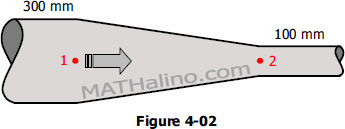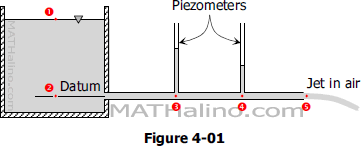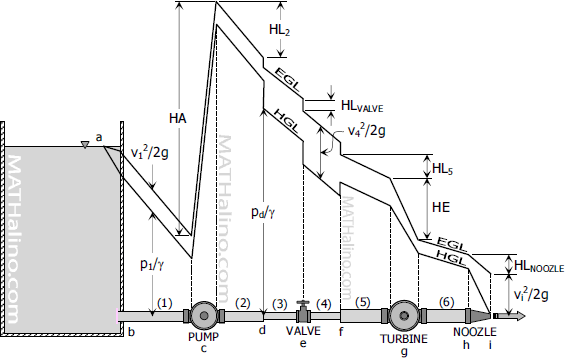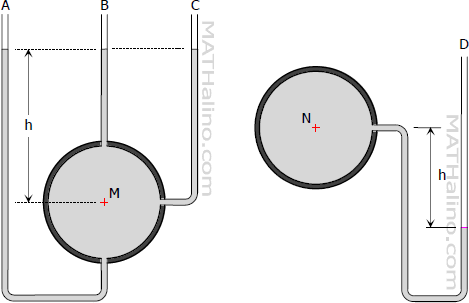Pressure Head
Problem 03 - Bernoulli's Energy Theorem
Problem 3
A 300-mm pipe is connected by a reducer to a 100-mm pipe. See Figure 4-02. Points 1 and 2 are at the same elevation, the pressure at 1 is 200 kPa. The discharge Q is 30 liters per second flowing from 1 to 2 and the energy lost from 1 to 2 is equivalent to 20 kPa.
- Compute the pressure at 2 if the liquid is water.
- Compute the pressure at 2 if the liquid is oil (sp gr = 0.80).
- Compute the pressure at 2 if the liquid is molasses (sp gr = 1.5).
- Read more about Problem 03 - Bernoulli's Energy Theorem
- Log in to post comments
Problem 02 - Bernoulli's Energy Theorem
Problem 2
From Figure 4-01, the following head losses are known: From (1) to (2), 0 m; from (2) to (3), 0.60 m; from (3) to (4), 2.1 m; from (4) to (5), 0.3 m. Make a table showing elevation head, velocity head, pressure head, and total head at each of the five points. How high above the center of the pipe will water stands in the piezometer tubes (3) and (4)?
- Read more about Problem 02 - Bernoulli's Energy Theorem
- Log in to post comments
Energy and Head of Flow
Energy is defined as ability to do work. Both energy and work are measured in Newton-meter (or pounds-foot in English). Kinetic energy and potential energy are the two commonly recognized forms of energy. In a flowing fluid, potential energy may in turn be subdivided into energy due to position or elevation above a given datum, and energy due to pressure in the fluid. Head is the amount of energy per Newton (or per pound) of fluid.
Kinetic Energy and Velocity Head
Kinetic energy is the ability of a mass to do work by virtue of its velocity. The kinetic energy of a mass M having a velocity v is ½Mv2. Since M = W/g,
$\text{Velocity head} = \dfrac{K.E.}{W} = \dfrac{v^2}{2g}$
Elevation Energy and Elevation Head
In connection to the action of gravity, elevation energy is manifested in a fluid by virtue of its position or elevation with respect to a horizontal datum plane.
$\text{Elevation head} = \dfrac{\text{Elevation energy}}{W} = z$
Pressure Energy and Pressure Head
A mass of fluid acquires pressure energy when it is in contact with other masses having some form of energy. Pressure energy therefore is an energy transmitted to the fluid by another mass that possesses some energy.
$\text{Pressure head} = \dfrac{\text{Pressure energy}}{W} = \dfrac{p}{W}$
- Read more about Energy and Head of Flow
- Log in to post comments
Manometers
- Read more about Manometers
- Log in to post comments
Problem 11 - Variation of Pressure
Problem
A pressure gage on the discharge side of a pump reads 300 kPa. Oil (sp gr 0.82) is being pumped. Compute the pressure head in meters of oil.
- Read more about Problem 11 - Variation of Pressure
- Log in to post comments
Problem 09 - Variation of Pressure
Problem
The pressure in a gas tank is 2.75 atmospheres. Compute the pressure in kiloPascal and the pressure head in meter of water.
- Read more about Problem 09 - Variation of Pressure
- Log in to post comments
Variation of Pressure with Depth in a Fluid
Consider two points 1 and 2 lie in the ends of fluid prism having a cross-sectional area dA and length L. The difference in elevation between these two points is h as shown in Figure 02 below. The fluid is at rest and its surface is free. The prism is therefore in equilibrium and all forces acting on it sums up to zero.
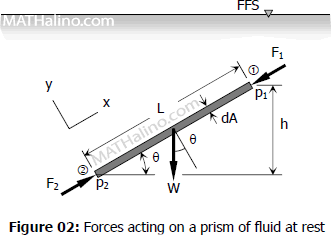
Note: FFS stands for Free Fluid Surface which refers to fluid surface subject to zero gauge pressure.
- Read more about Variation of Pressure with Depth in a Fluid
- Log in to post comments

